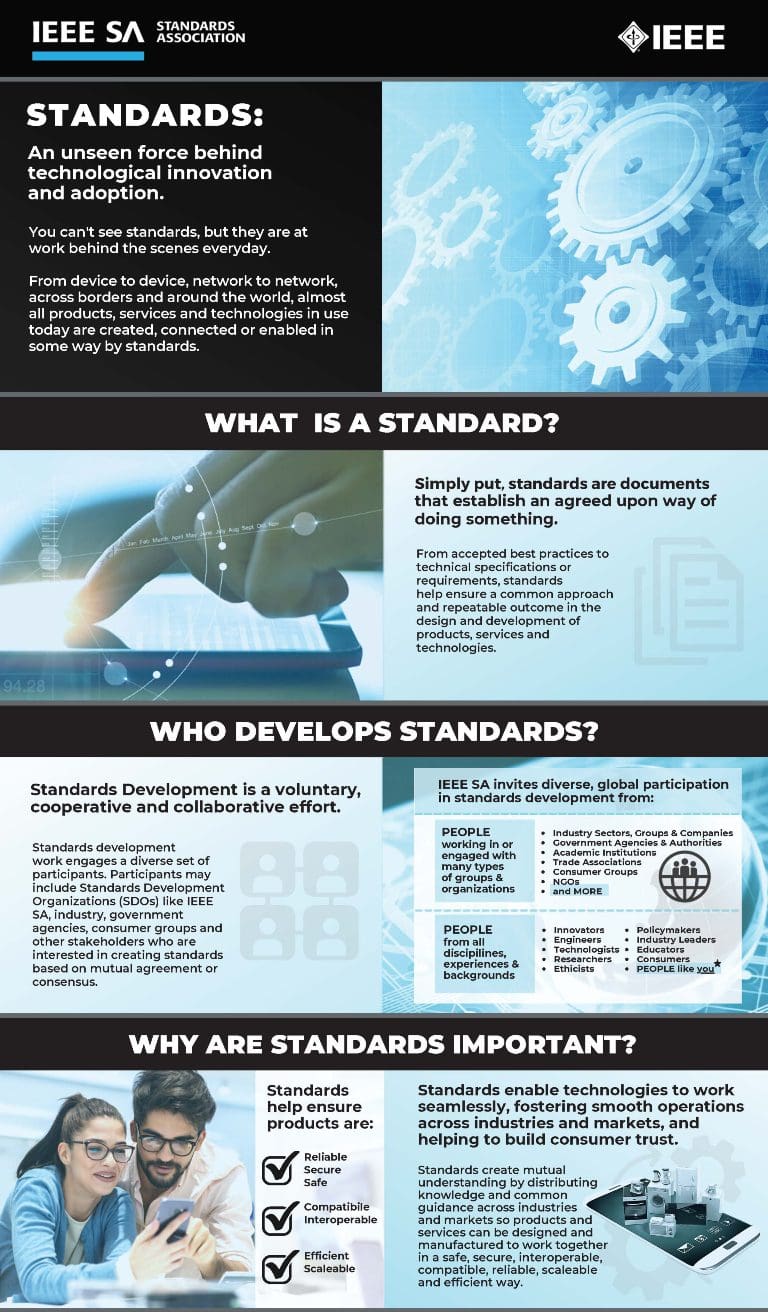Your smartphone’s alarm just went off. A new day begins. In the shower, you rock out with your Bluetooth speaker playing. Then you check and log your blood pressure and other vital signs on your personal health device. During breakfast, you browse the Internet using Wi-Fi. Before heading out, your home security system activates as it detects you closing the garage door.
In the garage, you unplug your electric vehicle (EV). When it starts, you see that overnight, it downloaded a map update and your latest music playlists.
During your commute, you safely zip along because your EV communicates with other vehicles and intelligent transportation infrastructure to help avoid accidents.
From the time you woke up to the time you arrive at work, you’ve used dozens of technology standards. But you probably didn’t know it, which is a good thing — and a major reason why standards exist and make your everyday life easier.

What are Standards?
Standards are published documents that establish technical specifications and procedures designed to maximize the reliability of the materials, products, methods, and/or services people use every day.
A standard can be thought of as an agreed-upon norm used by people, industry, and government that outlines the best way to complete a task – whether it’s about developing a product, providing a service, controlling a process, or interacting with the world.
Technology standards can also provide a framework that enables devices from different manufacturers to communicate with one another. That’s why, for example, your EV automatically connects to your home Wi-Fi network as soon as you pull into the garage. You didn’t have to think about connecting. It all happened automatically, behind the scenes, ensuring that your maps and playlists are always up to date.
In the process, standards provide a stable but continually evolving foundation that enables entire industries to develop and thrive. Think of standards as recipes. By following them, manufacturers get highly detailed information about how devices identify one another, how data flows between them, and how it’s kept secure, to name just a few examples.
Why are Standards Important?
Standards form the fundamental building blocks for product development by establishing consistent protocols that can be universally understood and adopted. This helps fuel compatibility and interoperability and simplifies product development, and speeds time-to-market. Standards also make it easier to understand and compare competing products. As standards are globally adopted and applied in many markets, they also fuel international trade.
For example, a standard provides detailed information that saves manufacturers enormous amounts of time and money when developing products. They don’t have to create that framework from scratch, troubleshoot and refine it, and convince other manufacturers to implement it. By adopting a standard, they’re both joining and leveraging an ecosystem of like-minded companies and other organizations.
Meanwhile, when consumers and businesses are confident that products will work as expected, they’re far more likely to buy them. Standards-based interoperability also gives them the freedom to mix and match different manufacturers’ products.
How are Standards Created?
To understand these and other benefits, it helps to look at how standards are created, revised, and used. One of the world’s largest standards organizations is the IEEE Standards Association (IEEE SA), which brings together a broad range of people and organizations from different technical and geographic points of origin into “working groups” that are open to anyone to participate. Many standards are used by multiple industries, such as health care, automotive, and consumer electronics. That’s why IEEE SA welcomes stakeholders from each vertical market that could use a standard under development.
These volunteer working groups create a collaborative environment for developing standards. Suppose members of a working group come together because they agree that there needs to be a new way for devices to transfer moderate amounts of data over short distances, with very low power consumption to maximize battery life. That’s how the IEEE 802.15.1™ Bluetooth standard was developed — and why your earbuds, smartphone, and smartwatch all can communicate seamlessly with one another.
Over the course of a standard’s development, the working group takes this kind of basic concept and fleshes out the technological aspects, processes, and other key attributes of how it can be achieved. These help ensure product functionality and compatibility, facilitate interoperability and support user safety, and data security and privacy.
How are Standards Used?
Once they’ve reached a consensus on all of these details, the working group publishes the initial draft of the standard. That’s what manufacturers and others follow to turn the concept into reality, such as a device that you can buy.
EVs are an example. The IEEE 2030.1.1™ standard, published in 2015, specifies the design interface of EVs and direct current (DC) quick chargers that promote interoperability and rapid charging.
Standards are also used as criteria for conformance testing and certification programs that help ensure goods and services conform to established technology and industry standards. There are many benefits to standards conformity and certification programs, including increased consumer and buyer confidence in end products.
The IEEE SA Conformity Assessment Program (ICAP) spans a wide variety of industries and applications, such as electrical equipment for nuclear power, telecommunications devices, and EVs. One example is the Distributed Energy Resources (DERs) Program.
Based on IEEE 1547™, a standard for renewable energy and smart grid, the program works with regulators and utilities to eventually help communities integrate renewable energy resources such as wind, solar, and hydropower, enabling a more reliable and resilient grid for your home.
Another example is the Camera Phone Image Quality (CPIQ) Program. Based on IEEE P1858™, this program helps enable an industry-supported and easily understood consumer rating system to provide you with comprehensive and accurate evaluations of the image quality for your smartphones, tablets, and other mobile devices. Besides helping make your photos and videos look great, CPIQ also supports the cameras that your EV and other vehicles use to avoid accidents.
How You Can Get Involved in Developing Standards?
If you’re interested in helping refine existing standards or develop tomorrow’s, IEEE SA is a great place to start. IEEE SA members are the driving force behind the development of hundreds of standards, providing technical expertise and innovation, driving global participation, and pursuing the ongoing advancement and promotion of new concepts.
Everyone is welcome to participate in IEEE SA activities beyond standards development. IEEE SA Individual and Corporate Members enjoy additional benefits, including enhanced participation in IEEE SA program activities and IEEE SA governance, as well as expanded roles in standards development, including the ability to vote on standards and assume leadership positions in standards working groups.
Whether you are looking to make your mark as an individual or on behalf of your organization, there are many ways to get involved with IEEE SA. Discover and explore the various opportunities to make a meaningful impact for the benefit of humanity.









Great introduction explaining the importance of standards.
Thanks for the update and i really liked the way you have explained the things.
It has given me a good introduction to the topic.
Thank you so much for writing this.
you covered up all the points which i searching for & I am impressed by reading this article. Keep writing and sharing educational article like this which can help us to grow our knowledge.
Thanks for your efforts.
Wow it is really wonderful and awesome thus it is very much useful for me to understand many concepts and helped me a lot. it is really explainable very well and i got more information from your blog.
Really informative post. I read some post of the site and find those very much helpful like this post.
Thank you so much for sharing
Thanks for providing such a piece of knowledgeable information.
Thank you so much for Sharing
Great Post! it is very helpful for me and all for those who want to learn.
I really appreciate your topic. This is something new I found on internet. I read almost full of your post.
thanks for incredible Information
Im impressed with the quality and well researched content written in this website.
It was really a good experience after reading your blog
I recently came across your article and have been reading along. I want to express my admiration of your writing skill and ability to make readers read from the beginning to the end.
I think this is one of the best blogs
Great content!! I Will definitely visit this site again to read more intrusive articles like these.
You have briefed the IEEE standards which are mostly used in the communication field. Your theory is most understandable.
I believe there are many more pleasurable opportunities ahead for individuals that looked at your site.
Your good knowledge and kindness in playing with all the pieces were very useful. I don’t know what I would have done if I had not encountered such a step like this.
Your new valuable key points imply much to a person like me and extremely more to my office workers. With thanks; from every one of us.
Thanks a lot very much for the high quality and results-oriented help. I won’t think twice to endorse your blog post to anybody who wants and needs support about this area.
It’s great to come across a blog every once in a while that isn’t the same out of date rehashed material. Fantastic read.
I ‘d mention that most of us visitors are endowed to exist in a fabulous place with very many wonderful individuals with very helpful things.
It’s always so sweet and also full of a lot of fun for me personally and my office colleagues to search your blog a minimum of thrice in a week to see the new guidance you have got.
I simply wanted to write down a quick word to say thanks to you for those wonderful tips and hints you are showing on this site.
And indeed, I’m just always astounded concerning the remarkable things served by you. Some four facts on this page are undeniably the most effective I’ve had.
Thank you a lot for providing individuals with a very spectacular possibility to read critical reviews from this site.
this article is very nice thanks for share
thank you for all free info really great article .